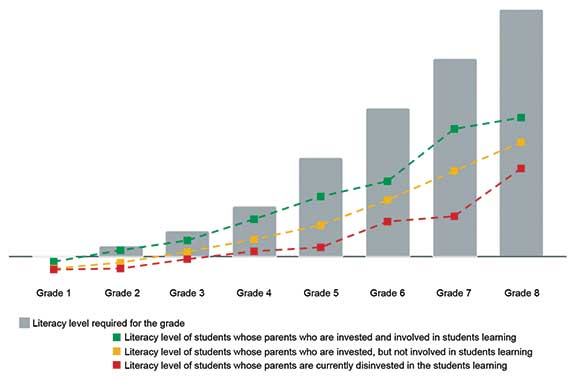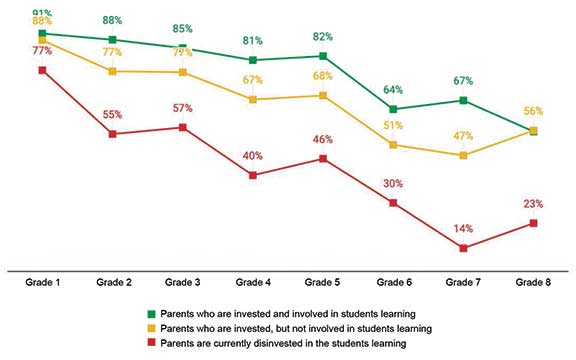Manasa Sunkavalli and Vignesh Krishnan
The COVID-19 pandemic has brought the importance of family-school engagement to the forefront of education discussions worldwide. Parent engagement in their child’s education has become an essential aspect, particularly in the current blended learning scenario where the role of parents has become more important than ever.
The last two years have witnessed a significant shift in the way educators have reimagined their partnership with parents. The Centre for Universal Education at Brookings published a report (2021) on family-school engagement, noting a shift from traditional parent-teacher meetings to newer methods of engaging parents in their children’s education at home. Surveys conducted in countries such as Colombia, India, Mexico, Peru, and the United States have revealed an increasing demand for new approaches to working with schools (Molina et al., 2020).

Many school leaders had a breakthrough realization – families previously thought to be uninterested in engagement were actually eager, but previous school approaches simply fell short. For example, when the Government of Himachal Pradesh shifted from asking parents to come to schools for meetings to reaching out to parents through text messages, WhatsApp groups, and Facebook posts, engagement levels jumped from 20 per cent to 80 per cent in just two months. This highlights the importance of finding new and innovative ways to engage with families, especially those who have been traditionally hard to reach (Brookings Institution, 2021).
Research has consistently shown that effective schools have high levels of parental and community involvement. A study conducted across 200 public elementary schools in Chicago found that family and community engagement was a key factor in determining whether schools could substantially improve students’ reading and maths scores (Byrk, 2010). Furthermore, a meta-analysis of 52 studies found that engaging parents in their children’s schooling leads to improved grades for students in their classes and on standardized tests (Jeynes, 2007).
But how exactly can family-school engagement lead to improved student outcomes? One example of a successful family-school engagement program is the “Family-School Partnerships Framework” adopted by a school district in Texas.
The framework encouraged sustainable and effective synergies between all stakeholders of the school community, including teachers, families, and students. The program provided opportunities for families to actively participate in their child’s education, including regular parent-teacher conferences and workshops on how to support their child’s learning at home. As a result, the district saw a significant improvement in student attendance, academic performance, and behaviour.
Family-school engagement has been proven to significantly improve the way education systems serve their students, especially those families that come from disadvantaged backgrounds. Studies have shown that schools with strong family engagement are ten times more likely to improve student learning outcomes (Byrk, 2010).
At Teach For India, we observed parents grappling with multiple challenges, such as job loss, paying fees, and uncertainty about their health, while also trying to support their children in adapting to the new mode of learning during the pandemic. This prompted the organization to adopt a new approach to deepen our understanding of working with parents. When we embarked on conducting extensive research, we were keenly aware that the needs and realities of parents/caregivers are diverse, and thus the challenge of parent engagement is also deeply contextual. This article aims to capture our learnings and best practices over the last two years, while working with over 31,000 parents from disadvantaged backgrounds across eight cities.
While reimagining various ways to work effectively with parents, we learnt that there was little to no evidence internally to measure the level of engagement of our parents across all our cities. This was a crucial initial step in designing interventions to work with our parents. The need to generate robust evidence led to the development of the parent investment scale. Through this scale, we established a simple system to track the data of approximately 31,000 students. We constructed a four-point scale where our Teaching Fellows, who are placed in a classroom to teach, filled in the data for each student in a Google sheet based on their conversation with each parent as well as their own observations. The parent investment scale was categorized as follows:
- Parents who are invested and involved
- Parents who are invested, but not involved
- Parents who are disinvested/passive
- Parents who are disinvested, abusive and/or violent
Our Teaching Fellows employed a standardized tracking system (a sample image of the tracker is mentioned below) to consistently collect data on students, their academic performance in reading and math, as well as parent engagement data. We collected the data on a monthly basis and analyzed it across classrooms, which our Fellows used to design appropriate interventions based on their context.

The above table shows the data for a grade 5 classroom with 22 students. The parent investment data is collected by the teaching Fellow using the rubric mentioned above. The reading level of the student refers to the grade level text up to which the student is able to read and comprehend. (For example: Aditya Malke is able to read and comprehend up to a grade 3 text). Math Mastery refers to % of mastery scored on a math assessment that tests for grade 5 concepts.
Parent engagement and its impact on learning outcomes
While the exercise to design a parent engagement scale was aimed towards building a shared language to determine the level of engagement, it also showed significant correlation to the learning outcomes of the students. Based on the data that was collected, we observed that ~51% of parents fall under category 1 where parents are invested and involved – meaning, they attend all parent engagement spaces and are able to provide learning support at home (2) ~36% of parents fall under category 2 where parents are invested but not involved, meaning they attend some spaces and are able to provide some support at home, but are not involved in the learning of their child; the rest 13% fall under category 3 and 4 where parents are disinvested, meaning their support is either inconsistent or absent. As we set out to understand the implications of parent involvement on student learning outcomes, we found a strong correlation between parent involvement in their children’s learning and literacy/numeracy outcomes of students across grades. The following chart provides a snapshot of the correlation between parental involvement and student learning outcomes.

The above chart shows the literacy level required by students across each grade and the current literacy level of students whose parents are able to provide consistent support vs literacy level of students whose parents are unable to provide consistent support.
While the students across government and low income private schools (for whom the data is collected) are behind grade level across all grades, the gap is relatively smaller for students whose parents are able to provide support towards learning at home. For example : In grade 8, On an avg. the literacy level of students whose parents are able to provide consistent support at home (Green) are able to read and comprehend a grade 6 text while those whose parents do not provide consistent support (Red) are unable to even read or comprehend a grade 5 text.
The data in the chart displays the correlation between parent investment and students’ ability to pass math assessments. The chart shows the percentage of students who are able to clear grade level math paper by parent investment. 88 per cent of students whose parents provide consistent support towards learning at home are able to clear math assessments as compared to 55 per cent of students whose parents are unable to provide support towards learning at home.

Across all grades, similar to literacy levels, numeracy outcomes of students whose parents are able to provide consistent support at home (Green) are much higher than that of students whose parents are unable to provide consistent support at home (Red).
Parent engagement bright spots
At Teach for India, our Teaching Fellows in their second year are required to execute a ‘Be the change project (BTCP)’ that endeavours to solve key barriers towards holistic student learning. Two of our Fellows teaching elementary grades identified that parents being the key stakeholders could help in accelerating the learning growth of students by remediating topics which are covered in school as well as by creating a healthy learning environment at home. Towards this project, these Fellows upskilled parents by teaching them a set of foundational literacy and numeracy concepts/ tools which parents could use to teach their children at home.
Similarly, in rural Ghana, an initiative known as Lively Minds is working to bridge the gap between families and schools by engaging mothers, many of whom have not had formal education themselves, to play an active role in their children’s early education. This initiative addresses the common belief among these mothers that they cannot play a role in their children’s education. Institute for Fiscal Studies & Innovations for Poverty Action (IFS & IPA) in 2019 noted that the program has been able to create innovative approaches to effectively bring families and schools together for the benefit of the children.
In conclusion, parent engagement is crucial for the academic and social success of children, especially those coming from disadvantaged backgrounds. By fostering a positive and open relationship with parents, educators can gain valuable insights into their students’ needs and help ensure that each child reaches their full potential. Additionally, involving parents in the classroom and school can lead to a stronger sense of community and shared responsibility for student success. Educators should make an effort to communicate regularly with parents and actively seek out their involvement in their child’s education. Similarly, it is also critical that institution builders and policy makers view parents as critical stakeholders while designing interventions for children.
Manasa Sunkavalli works with Teach For India as Impact & Learning Manager. She currently works with 8 regional teams to set up their monitoring and evaluation systems and coach teams to use data effectively.
Vignesh Krishnan works as the City Director, leading the strategy and operations for the regional site at Hyderabad.
They can be reached at manasa.sunkavalli@teachforindia.org / vignesh.krishnan@teachforindia.org.
